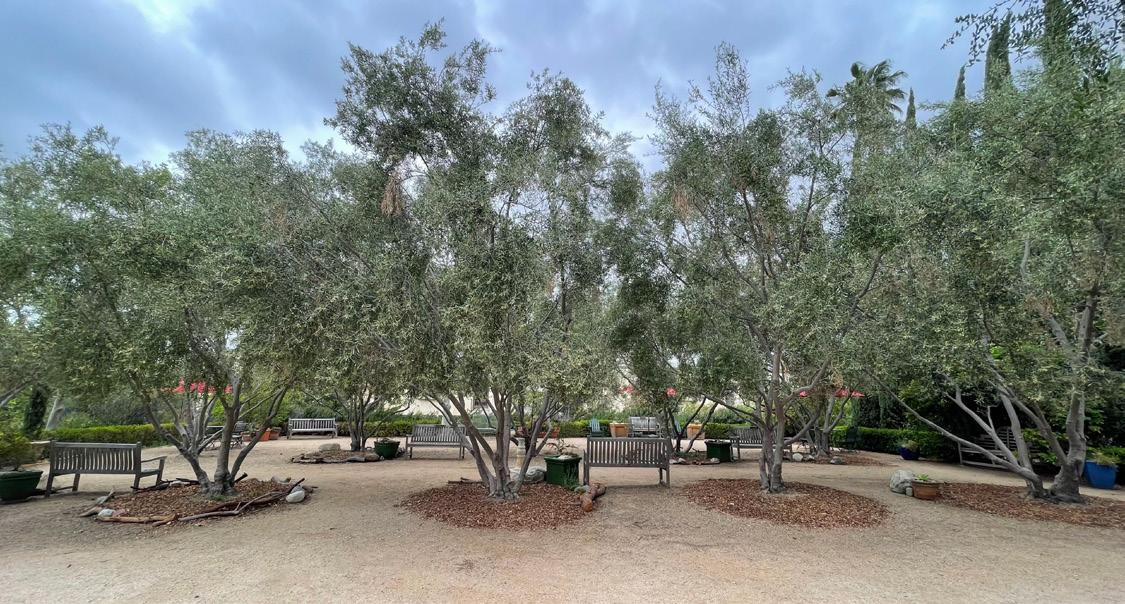
2 minute read
coast live oak
SYCAMORE TREES ARE APPARITIONS of riparian and seasonally wet habitats across Central and Southern California extending into Mexico. The white and grey trunks of mature specimens can reach several yards in circumference, growing at odd angles from the ground with branches bent and leaves muttering in the wind. The local El Cajon author and postal worker W.S. Head fancifully but correctly called this species “the Queen of the elfin forest” and cites “someone” as calling it “the ghost that stands with its feet in the water.”

Advertisement
The Arroyo Seco Forest
Arlington’s western sycamores grow towards the bottom of the slope running the length of the garden. When it rains, this section of the garden becomes a temporary wetland: ideal habitat for this species.
Some of the water in this seasonally flooded area is absorbed by plants; some of it evaporates; a bit may trickle deep down into the aquifer. The rest of the water ends up in the Los Angeles River drainage basin, which is just to say that we are in the Los Angeles River watershed. The garden borders the Arroyo Seco Watershed to the west, itself a part of the larger Los Angeles Watershed, once home to many western sycamores.
The Arroyo Seco is the prominent river of the Pasadena area. Although it contains relatively little water for much of the year, for millennia it has been the site of cataclysmic floods carrying sediment and uprooted forests down the mountains. The flood of 1861, for example, was described 29 years later in biblical terms: it was as if “the windows of heaven were opened, and the waters prevailed exceedingly on the face of the earth.” According to reports, the effects of the flood were multiplied by a raft of “driftwood,” no doubt containing many sycamores, pulled down the arroyo, forming small dams that channeled floodwater toand-fro. In another large flood five decades later, 43 people lost their lives. In response, large portions of the river below Devil’s Gate Gorge were straightjacketed in concrete.
Western sycamores require large flood events to reproduce in quantity, since flooding deposits the clean silt, cobble, and gravel conducive to seed germination. Likely because the Arroyo floods are now gone with the channelization complete, the sycamore forest surrounding the river is much reduced.
A Mnemonic Device
Observe the thin dappled bark and twisted boughs of Planatus racemosa trees in the garden. Touch the trunk. Can you feel the slightly raised edge between the lighter patches of bark and the darker patches? The outer bark does not expand at the same rate as the interior bark, so the outside layer sloughs off, forming a mottled pattern. This distinctive pattern, combined with the trees’ angled branches and trunks, suggests that sycamores have some sort of attrac- tive illness. Mostly, they aren’t sick: nonetheless, the impression is a good mnemonic device, since “sycamore” is pronounced “sick-amore.”
El Aliso
For reasons unknown to the author of this guide, the Spanish word “aliso,” which means “alder,” is used to refer to western sycamores. The most famous aliso probably ever was called “El Aliso”— “The Sycamore”— its name a bit literal in one sense and confusing in the other, since “aliso” means alder, but the definite article showing, at any rate, that it was peerless, the only real Aliso in a vast countryside of mere alisos.
El Aliso once stood in Yangna (or Yaangna), an Native American village once located where the present-day 101 freeway runs through downtown Los Angeles. The tree was enormous. It stood over 60 feet tall. Its trunk cont. p.37 »










